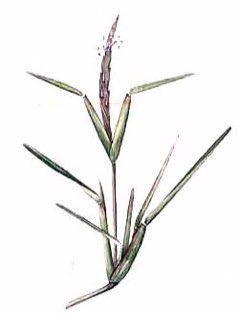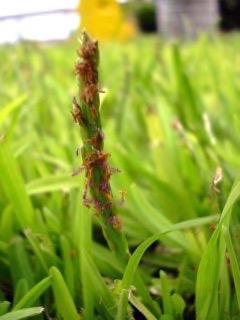 |
|
http://www.edibleplants.org |
 |
| Forest & Kim Starr wikimedia.org |
Translate this page:
Summary
Stenotaphrum secundatum, otherwise known as Buffalo Grass or St. Augustine?s Grass, is an evergreen, perennial grass that forms a thick sod. It is characterized by its dark green, broad, and flat blades. It is moderately tolerant to drought and can withstand flooding and waterlogged conditions. It is not edible and it has no medicinal uses. However, it is used in soil conservation as ground cover.
Physical Characteristics

 Stenotaphrum secundatum is an evergreen Perennial growing to 0.2 m (0ft 8in) by 0.1 m (0ft 4in) at a slow rate.
Stenotaphrum secundatum is an evergreen Perennial growing to 0.2 m (0ft 8in) by 0.1 m (0ft 4in) at a slow rate.
See above for USDA hardiness. It is hardy to UK zone 8.
Suitable for: light (sandy), medium (loamy) and heavy (clay) soils. Suitable pH: mildly acid, neutral and basic (mildly alkaline) soils and can grow in very alkaline soils.
It can grow in full shade (deep woodland) semi-shade (light woodland) or no shade. It prefers dry moist or wet soil and can tolerate drought.
UK Hardiness Map
US Hardiness Map
Synonyms
Diastemanthe platystachys Steud. Ischaemum secundatum Walter Rottboellia paleacea Steud. ex D?ll Rot
Plant Habitats
Edible Uses
References More on Edible Uses
Medicinal Uses
Plants For A Future can not take any responsibility for any adverse effects from the use of plants. Always seek advice from a professional before using a plant medicinally.
None known
References More on Medicinal Uses
The Bookshop: Edible Plant Books
Our Latest books on Perennial Plants For Food Forests and Permaculture Gardens in paperback or digital formats.

Edible Tropical Plants
Food Forest Plants for Hotter Conditions: 250+ Plants For Tropical Food Forests & Permaculture Gardens.
More

Edible Temperate Plants
Plants for Your Food Forest: 500 Plants for Temperate Food Forests & Permaculture Gardens.
More

More Books
PFAF have eight books available in paperback and digital formats. Browse the shop for more information.
Shop Now
Other Uses
Agroforestry Uses: The plant has a role as pasture or a soil conservation groundcover under trees, or near the sea where salt spray damages other grasses[415 ]. The plant is very tolerant of regular mowing[415 ]. It grows very well under coconuts, is planted with hedgerows of Leucaena leucocephala on coastal coralline plains and can grow with twining and stoloniferous legumes[415 ]. Once established, it forms a dense sward that crowds out weeds[375 ].
Special Uses
Ground Cover
References More on Other Uses
Cultivation details
A plant of the lowland tropics to the warm temperate zone. It is found at elevations up to 800 metres in the tropics. It grows best in areas where annual daytime temperatures are within the range 18 - 30°c, but can tolerate 10 - 34°c[418 ]. When dormant, the plant can survive temperatures down to about -4°c, but young growth can be severely damaged at -1°c[418 ]. Diploid types are more tolerant of cold and frost than many tropical grasses. Triploid forms have poor cool season growth[415 ]. It prefers a mean annual rainfall in the range 800 - 2,000mm, but tolerates 300 - 3,300mm[418 ]. Succeeds in full sun and also tolerates quite considerable shade[415 ]. Found on a wide range of well or poorly drained soils, from sandy loams to light clays[415 ]. Found in infertile to moderately fertile soils. It has good tolerance of soil salinity (to 15 dS/cm) and of wind-borne salt from the sea[415 ]. Prefers a pH in the range 6 - 7.5, tolerating - 8.5[418 ].While moderately drought tolerant, it prefers good moisture, and can also withstand temporary flooding and waterlogging[415 ]. There are some reports of the plant invading native habitats[305 ], but it has shown a low potential to become a problem[415 ]. Flowering Time: Blooms all year. Bloom Color: Inconspicuous/none. Spacing: Inconspicuous/none.
References Carbon Farming Information and Carbon Sequestration Information
Temperature Converter
Type a value in the Celsius field to convert the value to Fahrenheit:
Fahrenheit:
The PFAF Bookshop
Plants For A Future have a number of books available in paperback and digital form. Book titles include Edible Plants, Edible Perennials, Edible Trees,Edible Shrubs, Woodland Gardening, and Temperate Food Forest Plants. Our new book is Food Forest Plants For Hotter Conditions (Tropical and Sub-Tropical).
Shop Now
Plant Propagation
Seed -rarely produced[415 ]. The plant is normally propagated vegetatively because seed is not commercially available. To establish a good ground cover, use well-rooted sprigs or 7-10 cm plugs, planted 30cm apart in rows 60 - 70 cm apart[415 ]. The plant can also be established by broadcasting stolons or sprigs at 3.5 - 7 cubic metres per hectare and discing them into the soil and then rolling the ground[415 ]. The plants may take 5 - 6 months to form a complete cover, but establish faster under light to moderate shade[415 ].
Other Names
If available other names are mentioned here
gramilla, gramillón, pasto colchón, pelote, st. augustine grass.
Native Range
NORTHERN AMERICA: United States (Florida, Georgia (southeast), Louisiana (south), North Carolina (east), South Carolina, Mississippi (south), Texas), Mexico (east) SOUTHERN AMERICA: Hispaniola, Antigua and Barbuda, Bahamas, Cuba, Dominica, Guadeloupe, Jamaica, St. Kitts and Nevis, St. Lucia, Martinique, United States (Puerto Rico), Belize, Costa Rica, Guatemala, Honduras, Nicaragua, Panama, French Guiana, Guyana, Suriname, Venezuela (north), Brazil (east), Bolivia, Colombia, Ecuador, Peru, Argentina (northeast), Chile, Paraguay, Uruguay AFRICA: Cameroon, Côte D‘Ivoire, Ghana, Liberia, Nigeria, Senegal, Sierra Leone
Weed Potential
Right plant wrong place. We are currently updating this section.
Please note that a plant may be invasive in one area but may not in your area so it's worth checking.
There are some reports of the plant invading native habitats[305 ],
Conservation Status
IUCN Red List of Threatened Plants Status : This taxon has not yet been assessed

Growth: S = slow M = medium F = fast. Soil: L = light (sandy) M = medium H = heavy (clay). pH: A = acid N = neutral B = basic (alkaline). Shade: F = full shade S = semi-shade N = no shade. Moisture: D = dry M = Moist We = wet Wa = water.
Now available:
Food Forest Plants for Mediterranean Conditions
350+ Perennial Plants For Mediterranean and Drier Food Forests and Permaculture Gardens.
[Paperback and eBook]
This is the third in Plants For A Future's series of plant guides for food forests tailored to
specific climate zones. Following volumes on temperate and tropical ecosystems, this book focuses
on species suited to Mediterranean conditions—regions with hot, dry summers and cool, wet winters,
often facing the added challenge of climate change.
Read More
Expert comment
Author
(Walter) Kuntze
Botanical References
Links / References
For a list of references used on this page please go here
A special thanks to Ken Fern for some of the information used on this page.
Readers comment
| Add a comment |
|
If you have important information about this plant that may help other users please add a comment or link below. Only comments or links that are felt to be directly relevant to a plant will be included. If you think a comment/link or information contained on this page is inaccurate or misleading we would welcome your feedback at [email protected]. If you have questions about a plant please use the Forum on this website as we do not have the resources to answer questions ourselves.
* Please note: the comments by website users are not necessarily those held by PFAF and may give misleading or inaccurate information.
To leave a comment please Register or login here All comments need to be approved so will not appear immediately.
|
Subject : Stenotaphrum secundatum
|
|
|
|